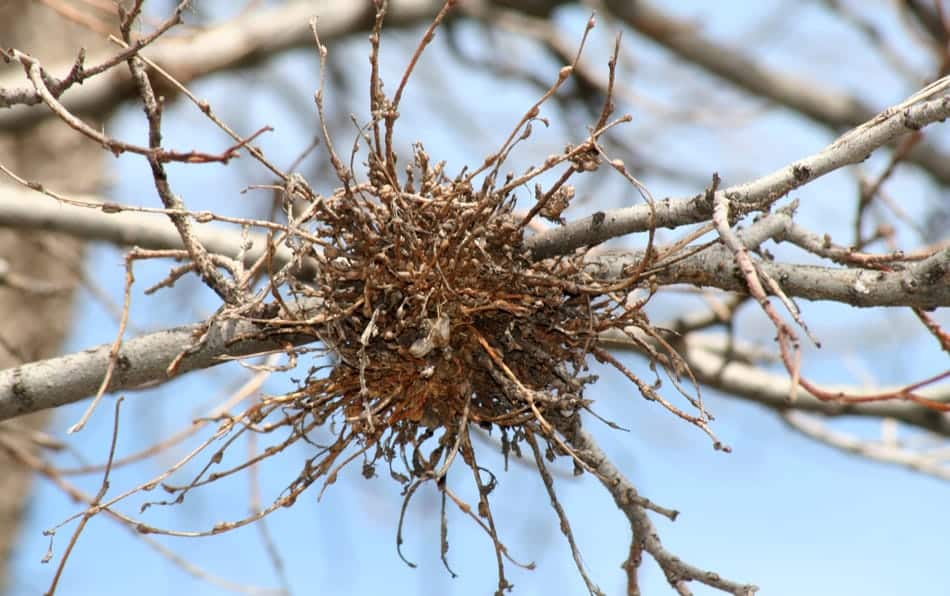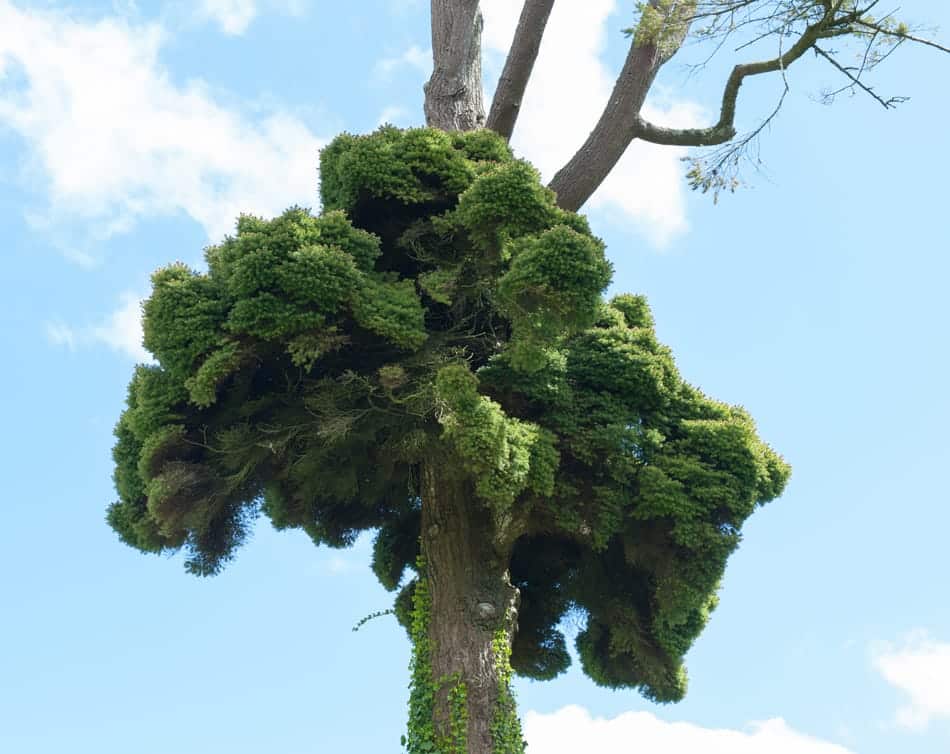It’s almost Halloween so it’s a good time to learn about witches’ brooms, but sadly not the flying kind.
The household brooms we use for sweeping are called brooms because they were once made from broom itself—the genus Genista, in the pea family, that includes many species of yellow-flowering plants with small, twiggy growth. These are the old-fashioned brooms that are made from bundles of small, irregular, flexible twigs bound to a long handle, not today’s corn or palm fiber brooms.
Nowadays, you may find similarly strange masses in your shrubs and trees, or even weird-looking growth on your rosebush. If you do, it might be witches’ broom.
How can I identify witches’ broom?
The more you look at plants, the more you see. Is that mass of twigs up in the crown of a deciduous tree a squirrel’s nest? Are those strange buds normal? Is that dense cluster of needles on the pine tree just vigorous growth? Maybe, or it might be witches’ broom.
Common signs of a witches’ broom include:
- a bunch of twigs or small branches growing from a central point (often growing around a larger branch)
- a ball-shaped dwarf plant growing in the tree
- an unusually dense cluster of foliage or needle growth
Read on for more information about this weird and fascinating condition that can be found on conifers, deciduous trees, vines, shrubs, and perennials.
What causes witches’ broom?
There are a number of things that can cause a witches’ broom to develop. Some tree species are susceptible to pathogens that cause a witches’ broom to grow in response, some common insect pests can cause it, and sometimes it’s just a genetic mutation (called a “sport”).
- Phytoplasmas are parasitical bacteria that make their home in the phloem, or food-transporting network of a tree. They’re usually transmitted to the plant tissue by an insect. Phytoplasmas can damage a wide range of plants, from wine grapes to coconut palms, by interrupting the flow of food and energy to the host plant.
- Insects, such as aphids and mites, can carry a pathogen that causes a witches’ broom to grow, and those pests can pass it along to the plant they’re infesting. For example, one of the symptoms of rose rosette disease is a witches’ broom; it’s caused by a virus that is borne by mites. Rosebuds and stems become stunted, grow many tiny leaves and excessive thorns (often they’re a strange red color), and the rosebuds do not open into flowers.
- Dwarf mistletoe is a parasite that infects pine species and other conifers. Dwarf mistletoe is not the green bunch that you hang in a doorway; it’s a small, leafless plant that grows on trees by taking water and nutrients from its host. The damage to tree tissue by the parasitic plant results in the deformed growth that makes a witches’ broom. For infected trees, this damage is often fatal as the irregular growth girdles branches and the mistletoe siphons the tree’s energy.
- Powdery mildew, a common fungus, has been known to cause oak trees (sp. Quercus) to develop witches’ brooms. A long period of rainy but warm weather can foster the growth of powdery mildew, and a witches’ broom is the tree’s response to an infection from the fungus. The strange appearance of leaf and stem growth can be the result of reduced photosynthesis where powdery mildew has covered leaf surfaces.

Witches’ broom produced by effects of an eriophyid mite and/or an associated powdery mildew producing fungus. Photo courtesy of
Whitney Cranshaw, Colorado State University, Bugwood.org
Which trees are more likely to develop a witches’ broom?
Pretty much any tree can develop a witches broom under the right conditions. We often see witches’ broom in Norway spruce here in central New Jersey, as well as in American beech. Other common species that develop witches’ broom in response to pathogens, insect pests, or stressful environmental conditions include:
- plane trees (Platanus),
- hackberry (Celtis),
- ash (Fraxinus),
- willow (Salix),
- walnut (Juglans),
- a number of evergreen conifers such as pine (Pinus) and fir (Abies),
- honeysuckle (Lonicera), and
- honey locust (Gleditsia) (although its natural habit of growing clusters of thorns can also resemble witches’ broom).
What about genetic causes?
Genetics can cause normal twig and needle growth to produce witches’ brooms, or “sports,” on conifers. The altered plant tissue often grows to form a ball of dwarfed needled twigs and branches in the tree’s crown. A notable difference between pathogen and parasite caused witches’ broom and a genetically caused witches’ broom is the health of the host tree. Conifers with genetic witches’ broom are healthy, and the sport itself looks like a tiny version of the species.
These naturally occurring miniatures are the source of some of the dwarf cultivars of conifers found in nurseries, such as ‘Blue Star’ juniper. This, and other, cultivars were developed by plant hunters and scientists who climbed trees to collect witches’ brooms, and then used cuttings from them to grow new plants that were healthy and carried the genetics for dwarfism.
Should I worry if I see witches’ broom in my tree?
The short answer is … it depends!
Most witches’ brooms are not fatal, just disfiguring. For example, irregular bud growth or overly dense areas on trees are unlikely to seriously injure the tree.
On the other hand, rose rosette disease is fatal and can spread to nearby roses as mites carry the virus from plant to plant. The current recommendation is to remove all parts of any affected roses (including roots and fallen leaves) and dispose of them in a sealed plastic bag.
Depending on the plant and the cause, witches’ broom may be:
- part of one year’s growth response and could be supplanted by normal growth in the future,
- shed when leaves fall and not recur the next year, or,
- as in the case of genetic creation, it could be just a part of an otherwise healthy conifer.
If you’re not sure what you’re looking at or what caused it, call the experienced tree care professionals at Organic Plant Care to help diagnose the problem. We can tell you if it’s benign, damaging, or fatal.
If your witches’ broom is caused by insect pests, we can also explain what controls to use to prevent it in the future.

Large witches’ broom in a douglas-fir
What should I do if my tree has a witches’ broom?
If the aesthetic appearance of your shrubs or trees is a concern, the first thing to do is to prune off the affected portions. Depending on the cause of a witches’ broom, removing affected branches, twigs, buds, or leaves may be all you need to do. Be sure to make your pruning cut at a proper location along a branch or twig before the affected portion.
Discard the cuttings right after pruning, rather than leaving them to decay into compost or leaf mold. This will reduce the availability of potential sources of reoccurrence, such as fungal spores or insects.
Clean your tools after using them to cut away a witches’ broom. Disinfecting a tool after each cut can limit the likelihood that you will transfer a damaging organism to an uninfected branch when you prune it.
If you’re not an experienced pruner, or if the witches’ broom is up in the crown of a mature tree, call us to handle the job. We know not just how to remove the affected portions (and have the training and equipment to do it safely), but whether or not it will solve the problem.
Powdery mildew damage, for example, can be removed by pruning, but pruning won’t prevent powdery mildew from coming back. Aphid infestations are another example; non-toxic sprays to kill aphids need to be applied at particular times and pruning isn’t required.
Our tree care professionals will also be able to tell you if external conditions are helping the growth of witches’ broom, as trees and shrubs under stress are more susceptible to developing it. Sometimes, removing or altering elements around your trees can increase their health and vigor, as well as their resistance to the causes of these growths.
HAPPY HALLOWEEN!
Witches’ broom has a long and interesting history. Once they were thought to be the product of witchcraft, with the masses in trees being thought of as both places that witches retreated to for rest and the vehicle for their flying. A witch’s broom cut from a tree might become a protective talisman, hung to keep animals safe.
We know now that folklore is not a substitute for science and scientific tree care, but the name has stuck and it connects us to our distant past.
GET THE LATEST NEWS
Subscribe to the Organic Plant Care Newsletter and get timely and helpful tips and updates monthly.
There's no spam - we promise!





